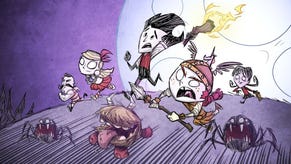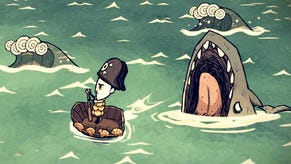Don't Starve: indie sandbox offers more than a Minecraft substitute
Random worlds, loads of crafting and a nighttime filled with terrors - is Don't Starve just a 2D Minecraft knock-off? Nope, Brenna says, finding lots to love in Klei's stress-inducing sandbox.
It's really hard to talk about Don't Starve without talking about Minecraft - but it's equally hard when discussing a not immodest collection of games that have popped up since Mojang's life-eater started making waves. Although these games vary significantly in execution - I'm thinking of things as varied as DayZ and Neo Scavenger here - there are a few common elements. You are alone in an inhospitable if not actively hostile environment, and must use what resources you can gather from a randomly generated selection in order to make your way in the world.
So now that we've got the inevitable comparison out of the way, let's talk about how Don't Starve differs. For one thing, it's harder. You start starving almost immediately, as soon as the game begins you're already losing. Every default random seed I've seen so far has thrown me down in a fairly friendly area with lots of things to eat and little effort required, but if you don't start actively sourcing more sustainable options immediately you'll rapidly run out of resources and find yourself losing a war of attrition.
On the other hand, wandering too far off in search of whatever your strategic first construction requires - say, Beefalo poop for farms - is a chancy business, because you may, in your distraction, end up in the middle of a desert with no food or firewood on hand, eating your precious supply of plantable seeds one by one and burning fistfuls of grass in a futile effort to see out the night.
Let's talk about the night. It lasts forever. It actually lasts for just a small segment of the clock - about one log's worth in a proper fireplace - and you don't have to worry about it will twilight fades completely (during the red portion of the clock, feel free to keep wandering and working). But when you're actually watching the dark close in, hearing the sounds of the night rise around you, fixedly staring at your last pine cone between darting your eyes at the clock, mumbling a prayer for it to last those last few seconds - it feels like forever. And the first time you lazily let the dark close in on you.
What Don't Starve really makes you feel is the scarcity of resources, and the importance of finding sustainable production chains - not just hunting and gathering. This really is survival. You're not here to use the world's bountiful resources to construct a magical kingdom and defeat an evil beast. You are eking out a miserable existence however you can, and it's eating away at your mind.
Getting back to Minecraft for a minute, there was a moment which I think most of us had, and which Penny Arcade captured perfectly, when the pleasure of experimentally putting two and two together suddenly turns into something that will result in you staring wildly at your housemate in the glow of dawn, lying about having been to bed.
In the post-Minecraft era, it's hard to recapture that feeling; you can only lose your crafting virginity once. Don't Starve gives you crafting recipes from the get-go rather than attempt to emulate that experience, but it still manages to serve up hefty doses of wonder and discovery, because it's more than a little bit odd, and it refuses to handhold.
When you start a new game of Don't Starve, you're just dropped in it. A creepy man leaves you to your fate. There's no tutorial whatsoever - not even a polite "click to move". Klei assumes, quite sensibly, that you know how to use a mouse and can figure out a simple, user-friendly interface on your own. Apart from the gentle reminder every day that "it will be dark soon" - a statement which is far too mild to convey its actual meaning - you figure things out as you go along. Why would Klei shove perfectly obvious information like how to control your character in your face, when it's not going to tell you anything more substantial?
Here are a few questions I came up with during my first few play sessions:
- Why am I here?
- Pig men? What?
- What is out there in the dark?
- Pig king? What?
- What the heck are those touch stone things?
- Pig houses? What?
- Why do the worm holes look so much like sphincters?
- Is there actually any way out of here?
- Is there any difference between these characters?
- How does the adornment of my skull with pretty flowers make me more sane?
Answering these questions on your tod is very cool. Of course you could also run off to the excellent wiki and get all the intel right away, but to Klei's credit, throughout the game's testing period it added mysteries almost as fast as the community solved them, leading to a kind of arms race. This created the kind of collaborative spirit From Software was aiming for with the Souls series - players struggling to unravel obfuscated gameplay systems, banding together to survive. It's neat.
I like Don't Starve a lot, but I like it for the same reason I like horror games - it stresses me out. I can't play too much of it, because I get invested in my hero's fate, and the constant battle against entropy is a little too similar to the emotions I experience every morning to be truly relaxing. I usually quit and delete my world well before I actually die, accepting the inevitable and determined to make a better go of it next time. The air of mystery, greatly helped along by Klei's deservedly lauded and consistently gorgeous trademark 2D graphics, is what makes pushing on through the stress worthwhile, and what keeps me coming back for just one more go.
Don't Starve is now available on Linux, Mac and PC, as well as for PlayStation 4, where it is an Instant Collection title for Plus subscribers.









